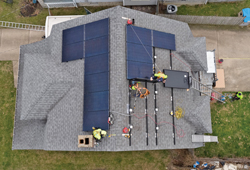Solar United Neighbors offers green energy alternative
by Dan Holland
Homeowners with an interest in investing in solar energy may want to investigate options through Solar United Neighbors, a nonprofit solar advocacy group. The organization provides cooperative buying programs that allow homeowners to take advantage of lower negotiated installation rates, according to Tristan Rader, Ohio program director for SUN.
“Through the co-op specifically, you’re going to beat the market prices by 10- 20%, and you know that you’ll be getting a solid product,” said Rader. “It’s a significant savings, and it gives you the best local option.”
Although the average cost for installation of a typical six-kilowatt solar array may run around $15,000, a 26% subsidy through the Investment Tax Credit is available to purchasers through the end of 2022.
“They’re going to get a quarter of that back in their taxes next year,” said Rader. “There’s a big incentive now, and then the incentive will be dropping to 22% next year and then going away in a few years. You’re seeing a rush right now of people getting solar due to the fact that it’s going to get more expensive with the subsidies going away.”
Rader explained that when a home or business is fitted for solar energy production, a connection to the local electric power grid is still maintained.
“At all times during the day – say if a cloud comes over – you’re going to draw a little bit of energy from the grid,” he explained. “When the sun comes back out, you put energy back onto the grid; it keeps going back and forth. It produces maximum power on sunny days, but it will always produce some amount of energy during the daytime.”
Although homes are generally fitted with a solar array designed not to produce more energy than required, excess power can be put back onto the grid. The transfer, known as net metering, then shows up as a credit on the homeowner’s bill.
“In months like May, June and July, [my home solar system] produces more energy than I use, and that goes onto the grid, and I get a credit on my electric bill, which I can draw down in the darker months,” said Rader.
Although Northeast Ohio is not known for an abundance of sunny days throughout the year, and cities such as Independence, Brecksville and Broadview Heights tend to be heavily wooded with a lot of shade, the average energy generation does not greatly differ when compared to sunnier regions of the country, according to Rader. An average solar array on a home in Northeast Ohio may produce approximately 1,200 kilowatts of power during the course of a year compared with a similar setup in Florida producing an average of 1,300-1,400 kilowatts per year, he said.
Nearly 200 homes in Cuyahoga County have been fitted with solar panels since the first solar power co-op in the county was formed in 2017. The average “break-even point” between energy savings and installation costs is generally around 11-12 years depending on the energy market, said Rader.
“It accomplishes the goals of homeowners in Northeast Ohio of lowering their energy costs and energy burdens and also keeping their own sustainability goals in reducing their own carbon footprint,” he said.
For further information, visit solarunitedneighbors.org/cuyahoga. ∞

